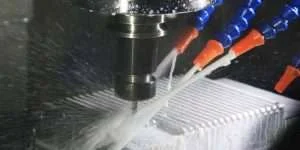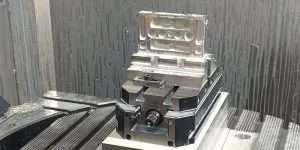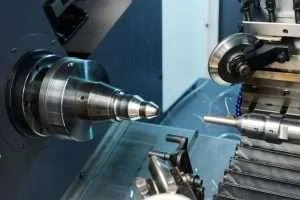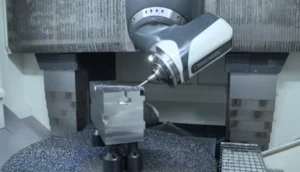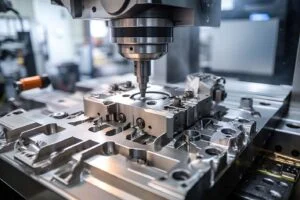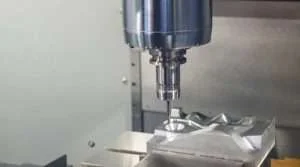Many lists of innovative machining materials can never be completed without Magnesium because of its qualities. However, machining comes with its fair share of challenges because of its flammable nature.
This article will deal with the challenges of CNC machining magnesium and its alloys along with the relevant safety precautions.

Magnesium Alloys and Their Properties
Magnesium and its alloys are naturally excellent when it comes to strength-to-weight ratio and machinability. It’s one of the lightest structural materials with an incredible strength-to-weight ratio, which means that it can offer greater durability and performance while being lightweight.
Apart from excellent strength and compatibility, CNC machining magnesium and its alloys bring a lot of other things to the table. For instance, the material naturally offers vibration dampening, electromagnetic shielding, and high thermal conductivity for specialized applications. Most importantly, Magnesium and its alloys are highly recyclable as well.

The chart above shows the properties of magnesium alloys. Reference
Key Challenges in CNC Machining Magnesium
Magnesium, while machinable, is a little dangerous to process. It’s a flammable material and requires many safety considerations. Let’s go into the main challenges associated with CNC machining magnesium.
“Magnesium is flammable during machining due to high heat generation. This can lead to ignition and burning of chips. The machining process also produces potentially explosive dust and discontinuous magnesium chips. Even a minor ignition source can trigger an explosion when these particles accumulate.” Guo, a CNC Machining Engineer at XinCheng, says.
Fire Hazards
CNC machining magnesium is a reactive material and the fine dust or chips created can catch fire very easily. Furthermore, Magnesium fires are not that easy to extinguish as the material itself can react with water and create hydrogen gas, which is even more flammable.

Excessive Heat Generation
CNC machining magnesium is an excellent conductor and while that can be an advantage for some applications, it hinders the machining process, which creates excessive heat. Different heat concentrations within the workpiece can create a lot of durability issues and may even cause deformation in the workpiece itself. Furthermore, excessive heat also contributes to tool wear and propagates damage in it.
Prone to Deformation
As discussed, the excessive heat generated in magnesium machining can cause deformations in the workpiece. Any material closer to its melting point loses its mechanical integrity and softens up. Magnesium, which is already a softer material can undergo deformation due to any excessive force from the machining tool with elevated temperatures.
Corrosion Concerns
Magnesium is a reactive element that can lead to corrosion. A lot of post-processes like oxidizing can prevent corrosion but there are chances of a reaction during the machining process. That’s precisely why magnesium or magnesium alloy CNC machining magnesium uses specialized coolants.

Important Safety Measures for CNC Machining Magnesium
The challenges in magnesium alloy machining may sound daunting. However, the process is quite effective and manageable in reality. All that’s needed is to be careful and follow some basic safety precautions. Here are a few important safety precautions for CNC machining magnesium.
Avoid Tight Clearances
Magnesium parts can be machined at higher speeds without compromising the quality. However, it is recommended to avoid tight clearances as doing so forms longer and unbroken chips that entangle with the cutting tool. Magnesium chips are flammable, and that can be a fire hazard.
Choose the Right Cutting Tools
It’s essential to keep the cutting tools sharp. Blunt tools will cause more friction by being in contact for a longer time and that can be a fire hazard again. One of the best ways to avoid this issue is to rely on carbide tools. They retain their hardness for a longer time and don’t produce sparks which is ideal for CNC prototype machining and its alloys.
Don’t Use Water-Based Coolants
In some cases, you can’t avoid heat generation during the machining process. Coolants are made for such instances as to prevent excessive heat generation. However, it’s important to remember that water-based coolants are not suitable for magnesium machining. CNC machining magnesium chips are flammable and they react with water to create hydrogen gas, which further exacerbates the fire hazard.
Mineral oil coolants are better for machining magnesium. They significantly reduce the risk of fire and even improve the overall surface quality of the product.
Make Discontinuous Chips
The type and size of chips formed during the machining process have a direct impact on the heat dissipation of the process. Discontinuous chips take away the heat from the workpiece and are less likely to ignite. A small back rake angle, moderate cutting speeds, low feed rate, and finally large cutting depths are the ideal settings that ensure the formation of discontinuous chips during CNC machining magnesium.
Fire-proof the Machining Setup
It’s a given that the CNC setup for magnesium machining needs fireproofing. However, a lot of facilities ignore that chip removal process, which also needs vacuum extraction to ensure no ignition occurs. The fire hazard remains even after the machining process is over, so it’s important to treat all the subsequent processes with the same care.
CNC Machining Techniques for Magnesium Parts
First of all, there are no right or wrong processes when it comes to manufacturing. Dealing with CNC machining magnesium is the same – there is no right choice. It all depends on the intricacies of the project and its constraints. Generally, the following CNC techniques are common for dealing with Magnesium and its alloys:
- CNC Drilling
- Fresado CNC
- Torneado CNC
- Tapping
Out of the above, CNC milling and turning are the most common because all the others are only used when there is a special feature in the design. For instance, internal threads in the design will need tapping. Otherwise, the process won’t be needed.
Let’s take a closer look at milling and turning techniques for CNC machining magnesium.

CNC Milling Techniques for Magnesium Parts
Milling machines play a pivotal role in machining magnesium and its alloys. The process for magnesium itself is exactly the same as any other milling process but requires better precision and cutting tool selection.
High-Speed Machining (HSM) for Magnesium Alloys
While discussing machining, especially milling Magnesium, High-Speed Machining stands out as an advanced technique that particularly suits Magnesium manufacturing. HSM relies on continuous tool engagement and high speeds for low-density materials like CNC machining magnesium. This significantly reduces the cutting force and enhances the overall productivity of the machining process.
CNC Turning Techniques for Magnesium Parts
Turning is a fundamental process for manufacturing. It works on parts with a rotational symmetry and has no material-specific needs. This means that the process of turning Magnesium is the same as any other material. The only additional considerations are that of safety which have already been discussed in this writeup.
Relatively, turning is not a common process as its applications are limited to products with a limited symmetry only. However, it is certainly a valuable process with a quick turnaround time and excellent tolerances.

Practices and Tips for Machining Magnesium
Manufacturing Magnesium requires precision and care for excellent performance. Here are a few machining tips to help get the most out of any Magnesium machining facility.
Focus on Safety
Prioritize safety over all things by investing in class D fire extinguishers and sand buckets. Also ensure that all the appropriate protective equipment, fire-resistant clothing, and other necessary items are available at all times.
Alloy Selection
Magnesium alloys are not cut from the same cloth as different alloys are made for different applications. Furthermore, the purity of CNC machining magnesium also affects the machinability. So, it’s essential to ensure that the right kind of material is selected for optimal performance.
Appropriate Tools and Cutting Speed
There are multiple cutting tool options, but carbide performs best for magnesium processing. Similarly, the right cutting and feed speeds are quite important. It’s best to consult the tool manufacturer’s recommendation for specific alloys for the best results.
Be Careful About Chip Control
Magnesium chips are a safety hazard and can also affect the overall machining quality. So, it’s important to maintain effective chip control measures and adjust the cutting parameters to create discontinuous chips that dissipate heat more effectively.
Minimize Vibrations for Better Accuracy
It’s essential to be careful about the fixtures being used. The appropriate fixture can have a dampening effect that minimizes chatter and improves the overall precision of the machining magnesium process.

Applications of CNC Machined Magnesium Parts
CNC machining magnesium parts are common across many industries because of their unique benefits. Magnesium is naturally lightweight, durable, and has a high strength-to-weight ratio. Its alloys also have corrosion-resistant properties and all of these features make it a versatile choice for a lot of industries.
Here are a few examples:
- Aerospace structures
- Medical devices
- Electronics and consumer goods
- Military applications
- Telecommunications
- Industrial machinery
- Renewable energy
- Marine applications
Get Magnesium Machining Services at XinCheng
CNC machining magnesium requires precision and experience that a reliable partner like Xcmachining can bring to the table. From machining rapid prototyping parts to creating complex parts for automotive or aerospace applications, we are capable and committed to meeting your requirements.
In addition, our commitment to quality is reflected in our machining capabilities. Whether you require milling, turning, or specialized machining processes, we have the technology and expertise to handle magnesium components. Xcmachining employs advanced Mecanizado CNC equipment, ensuring accuracy and efficiency in every project.
Preguntas frecuentes
What are the most important safety precautions for Magnesium machining?
The most important thing to remember is to prevent any fires during the machining process. Magnesium parts don’t catch fire, but the small chips and dust produced during machining are prone to fire and it’s important to prevent that from happening.
Is machining Magnesium considered expensive?
Generally, Magnesium machining is not as expensive as other materials like Titanium, but that doesn’t mean that the costs involved are not significant. Factors like machining complexity, post-processing, and tool costs, are some of the main factors that affect the overall prices of machining Magnesium parts.

